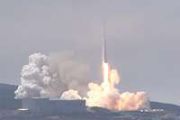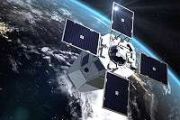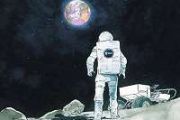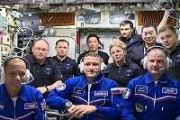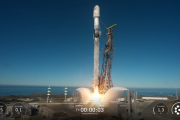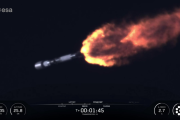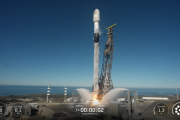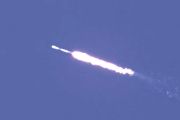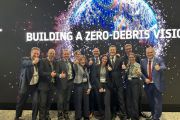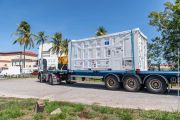
Copernical Team
China's tallest rocket deploys two satellites
 The launch of a modified Long March 7A carrier rocket on Thursday that sent two experimental satellites into space marked the debut mission of China's tallest rocket.
The 60.7-meter-tall rocket blasted off at 6:12 pm from a coastal launch tower at the Wenchang Space Launch Center in Hainan province before placing the Shiyan 12-01 and 12-02 satellites into their orbits, China Aerospace Scie
The launch of a modified Long March 7A carrier rocket on Thursday that sent two experimental satellites into space marked the debut mission of China's tallest rocket.
The 60.7-meter-tall rocket blasted off at 6:12 pm from a coastal launch tower at the Wenchang Space Launch Center in Hainan province before placing the Shiyan 12-01 and 12-02 satellites into their orbits, China Aerospace Scie DART returns first images from space
 Just two weeks after launching from Vandenberg Space Force Base in California, NASA's Double Asteroid Redirection Test (DART) spacecraft has opened its "eye" and returned its first images from space - a major operational milestone for the spacecraft and DART team.
After the violent vibrations of launch and the extreme temperature shift to minus 80 degrees C in space, scientists and enginee
Just two weeks after launching from Vandenberg Space Force Base in California, NASA's Double Asteroid Redirection Test (DART) spacecraft has opened its "eye" and returned its first images from space - a major operational milestone for the spacecraft and DART team.
After the violent vibrations of launch and the extreme temperature shift to minus 80 degrees C in space, scientists and enginee Holiday Prepping on Mar: Sols 3333-3343
 On Mars, like Earth, we are prepping for the holidays. Today we planned an eleven sol plan which will take us to the end of December. For this plan, the ENV instruments take the main stage, with lots of REMS activities and a rare day-long DAN passive experiment.
With such a long complex plan, contact science had to be short and sweet today. This current location is dotted with large nodula
On Mars, like Earth, we are prepping for the holidays. Today we planned an eleven sol plan which will take us to the end of December. For this plan, the ENV instruments take the main stage, with lots of REMS activities and a rare day-long DAN passive experiment.
With such a long complex plan, contact science had to be short and sweet today. This current location is dotted with large nodula Perseverance and the Search Amongst the Sand
 Since February 18, 2021, Perseverance has been exploring the Jezero crater floor, including an exposure of rock and sand that the rover's science team calls Seitah (which means "amongst the sand" in the Navajo language).
One of the main exploration targets within Jezero crater is the well-preserved delta deposit, and many of the predicted landing sites for the rover were clustered very nea
Since February 18, 2021, Perseverance has been exploring the Jezero crater floor, including an exposure of rock and sand that the rover's science team calls Seitah (which means "amongst the sand" in the Navajo language).
One of the main exploration targets within Jezero crater is the well-preserved delta deposit, and many of the predicted landing sites for the rover were clustered very nea Cargo Dragon Docks to Station with Brand New Science
 While the International Space Station was traveling more than 260 miles over the South Pacific Ocean, a SpaceX Dragon cargo spacecraft autonomously docked to the space-facing side of the orbiting laboratory's Harmony module at 3:41 a.m. EST, Wednesday, Dec. 22. NASA astronauts Raja Chari and Thomas Marshburn were monitoring docking operations for Dragon.
The Dragon launched on SpaceX's 24t
While the International Space Station was traveling more than 260 miles over the South Pacific Ocean, a SpaceX Dragon cargo spacecraft autonomously docked to the space-facing side of the orbiting laboratory's Harmony module at 3:41 a.m. EST, Wednesday, Dec. 22. NASA astronauts Raja Chari and Thomas Marshburn were monitoring docking operations for Dragon.
The Dragon launched on SpaceX's 24t World's most sophisticated commercial communications satellite launched
 Inmarsat, the world leader in global, mobile satellite communications confirms the successful launch of its first Inmarsat-6 satellite, I-6 F1, by Mitsubishi Heavy Industries (MHI) from the JAXA Tanegashima Space Center in Japan.
The Inmarsat-6s (I-6) are Inmarsat's first ever hybrid L- and Ka-band satellites, incorporating increased capacity and new technological advances for ELERA's tran
Inmarsat, the world leader in global, mobile satellite communications confirms the successful launch of its first Inmarsat-6 satellite, I-6 F1, by Mitsubishi Heavy Industries (MHI) from the JAXA Tanegashima Space Center in Japan.
The Inmarsat-6s (I-6) are Inmarsat's first ever hybrid L- and Ka-band satellites, incorporating increased capacity and new technological advances for ELERA's tran Virgin Orbit completes final launch rehearsal ahead of 3rd commercial launch
 Yesterday, Virgin Orbit, which has announced a planned business combination with NextGen Acquisition Corp. II ("NextGen") (NASDAQ: NGCA), completed a full wet dress rehearsal of its air-launched LauncherOne satellite delivery service, taking the integrated system through a full run of procedures to verify the health of the system and the preparedness of the team.
"The successful completion
Yesterday, Virgin Orbit, which has announced a planned business combination with NextGen Acquisition Corp. II ("NextGen") (NASDAQ: NGCA), completed a full wet dress rehearsal of its air-launched LauncherOne satellite delivery service, taking the integrated system through a full run of procedures to verify the health of the system and the preparedness of the team.
"The successful completion Scientists at PPPL and Princeton University demonstrate a novel rocket for deep-space exploration
 The growing interest in deep-space exploration has sparked the need for powerful long-lived rocket systems to drive spacecraft through the cosmos. Scientists at the U.S. Department of Energy's (DOE) Princeton Plasma Physics Laboratory (PPPL) have now developed a tiny modified version of a plasma-based propulsion system called a Hall thruster that both increases the lifetime of the rocket and pro
The growing interest in deep-space exploration has sparked the need for powerful long-lived rocket systems to drive spacecraft through the cosmos. Scientists at the U.S. Department of Energy's (DOE) Princeton Plasma Physics Laboratory (PPPL) have now developed a tiny modified version of a plasma-based propulsion system called a Hall thruster that both increases the lifetime of the rocket and pro NASA, private space industry may reach new heights in 2022
 Space exploration may shatter records in 2022 with the launch of the most powerful rocket ever in a flight beyond the moon, a space telescope that will peer into the dawn of the universe and groundbreaking science on Mars.
The New Year also may see SpaceX's deep space Starship rocket fly above the atmosphere, expansion of space tourism and new rocket launches from companies such as United
Space exploration may shatter records in 2022 with the launch of the most powerful rocket ever in a flight beyond the moon, a space telescope that will peer into the dawn of the universe and groundbreaking science on Mars.
The New Year also may see SpaceX's deep space Starship rocket fly above the atmosphere, expansion of space tourism and new rocket launches from companies such as United Ball Aerospace-built optics and mirror system launched aboard Webb Telescope
 Ball Aerospace is celebrating the launch of NASA's James Webb Space Telescope (Webb) from French Guiana. The Colorado-based company designed and built the advanced optical technology and lightweight mirror system that will enable Webb to detect light from the first stars and galaxies.
"It is truly an honor to be such an integral part of the next great space observatory," said Dr. Makenzie
Ball Aerospace is celebrating the launch of NASA's James Webb Space Telescope (Webb) from French Guiana. The Colorado-based company designed and built the advanced optical technology and lightweight mirror system that will enable Webb to detect light from the first stars and galaxies.
"It is truly an honor to be such an integral part of the next great space observatory," said Dr. Makenzie 

